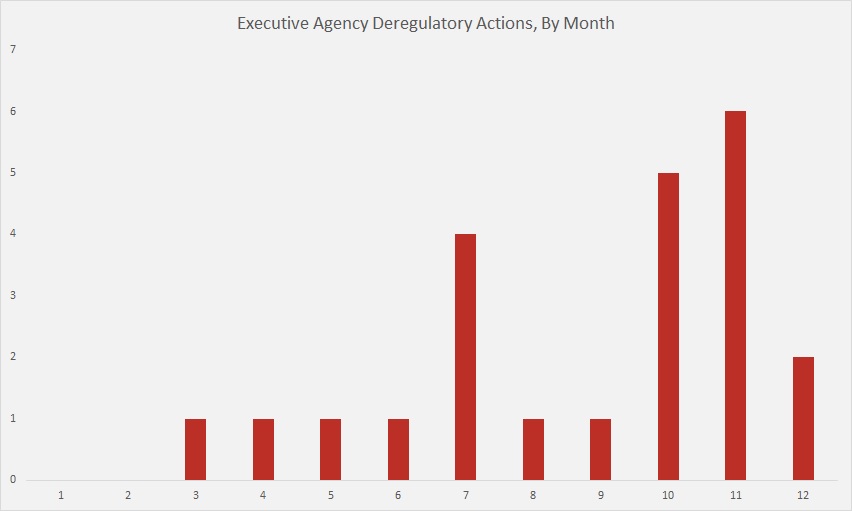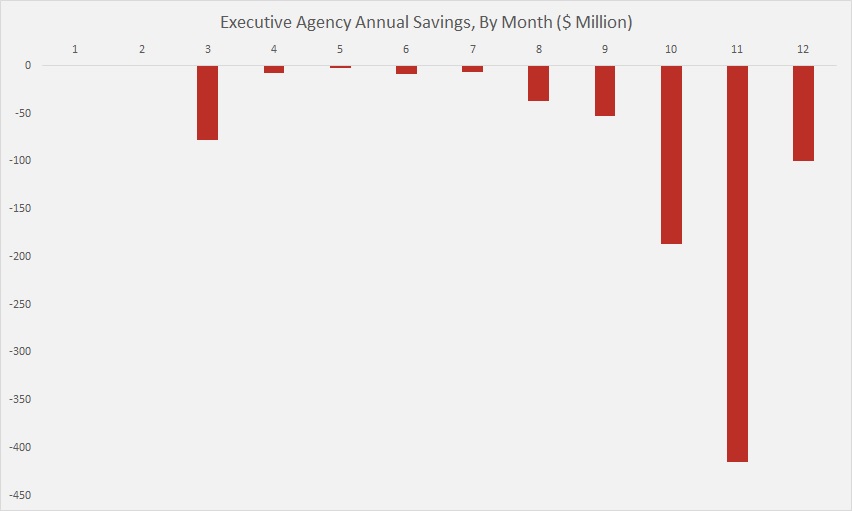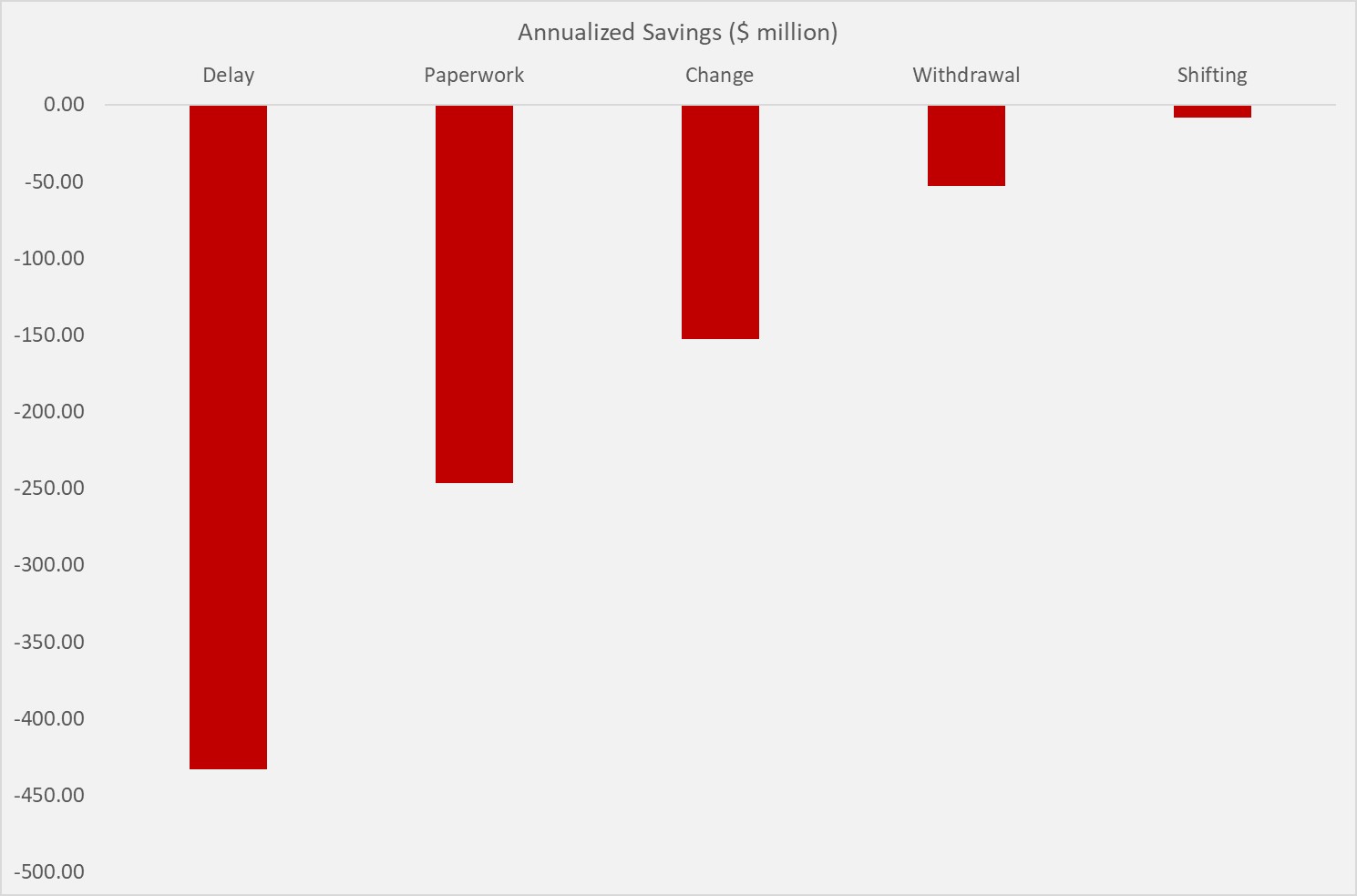Insight
January 23, 2018
Update: Deregulation Under Trump
In December, the American Action Forum (AAF) dug into the deregulatory actions of the Trump Administration to determine how regulatory cost savings were achieved. Now that the administration has completed its first full year, we once again look to see what shifts have occurred.
Overall, the Trump Administration published 23 final actions under its one-in, two-out executive order with estimated annualized cost savings. These actions totaled $893 million in annualized savings.
Our analysis shows that while the bulk of regulatory savings continue to be achieved through delays and paperwork changes, savings derived from substantive regulatory changes increased remarkably over the last two months of the administration’s first year.
METHODOLOGY
AAF analyzed the 23 rules classified as final Executive Order 13,771 deregulatory actions (those with estimated net annual cost savings) published in the Federal Register from January 23, 2017 through January 19, 2018. This analysis excludes rules nullified by the Congressional Review Act. Savings estimates were categorized by type based on a description of those savings offered in the Federal Register notice for each rule.
AAF identified five categories of savings:
- Delays (such as extending compliance deadlines)
- Paperwork (including information collection requests, applications, and reporting)
- Regulatory changes (modifications in how the regulation functions)
- Withdrawal of rules
- Shifting of responsibilities (away from public sector to contractors)
The rules are listed below:
| Regulation | Annualized Cost Savings (million) | Primary Category |
| 18-Month Extension of Transition Period and Delay of Applicability Dates; Fiduciary Rule | -$291.100 | Delay |
| Preliminary Fiduciary Rule Delay | -$78.000 | Delay |
| Postponement of Certain Compliance Dates for the Effluent Limitations Guidelines | -$36.800 | Delay |
| Student Assistance General Provisions, Federal Perkins Loan Program | -$9.247 | Delay |
| Delay: Nutrition Labeling of Standard Menu Items | -$8.000 | Delay |
| Cranes and Derricks in Construction: Operator Certification Extension | -$5.200 | Delay |
| Waste Prevention, Production Subject to Royalties, and Resource Conservation; Delay and Suspension | -$4.600 | Delay |
| Improve Tracking of Workplace Injuries and Illnesses: Delay of Compliance Date | -$0.021 | Delay |
| Medicare and Medicaid Programs; CY 2018 Home Health Prospective Payment System Rate Update | -$145.986 | Paperwork |
| User Fees for the Electronic Hazardous Waste Manifest System and Amendments to Manifest Regulations | -$66.000 | Paperwork |
| Medicare Program: Hospital Outpatient Prospective Payment and Ambulatory Surgical Center Payment | -$14.000 | Paperwork |
| Medicare Program; CY 2018 Updates to the Quality Payment Program | -$11.700 | Paperwork |
| Hospital Inpatient Prospective Payment Systems for Acute Care Hospitals | -$3.854 | Paperwork |
| Inpatient Rehabilitation Facility Prospective Payment System | -$2.564 | Paperwork |
| Fisher Houses and Other Temporary Lodging | -$1.990 | Paperwork |
| Revolving Loan Fund Program Changes and General Updates to PWEDA Regulations | -$0.961 | Paperwork |
| Control Order for Introduced Migratory Bird Species in Hawaii | -$0.006 | Paperwork |
| Metropolitan Planning Organization Coordination and Planning Area Reform | -$86.300 | Change |
| Oil and Gas; Hydraulic Fracturing on Federal and Indian Lands; Rescission of a 2015 Rule | -$34.000 | Change |
| Streamlining Administrative Regulations for Multifamily Housing Programs | -$31.200 | Change |
| Migratory Bird Subsistence Harvest in Alaska; Use of Inedible Bird Parts | -$0.362 | Change |
| Scope of Sections 202(a) and (b) of the Packers and Stockyards Act | -$52.860 | Withdrawal |
| Error Rate Measurement Programs in Response to the Affordable Care Act | -$8.380 | Shifting |
Of the 23 rules, only one clearly identified more than one cost-savings category: the Hospital Inpatient Prospective Payment Systems for Acute Care Hospitals rule, which accrued its savings primarily from paperwork reductions, with some from regulatory changes. Of its $3.9 million in annualized savings, $742,000 come from regulatory changes.
FINDINGS
The total annualized savings in the first year of the Trump Administration was $893 million. Like our first analysis, most of the savings were from delays in compliance deadlines and paperwork changes. Delays accounted for $432 million in annualized savings (48 percent). Paperwork changes totaled $246 million in annualized savings (28 percent).
The notable change from the first analysis is the increase in annualized savings from substantive regulatory changes. These changes resulted in $153 million in savings, or 17 percent of the total. Though less than one-fifth of all savings, it represents a substantial increase from the $1.1 million in annualized savings from our prior analysis. It makes sense that more of this category would occur later in the first year, given that regulatory changes need to go through the same regulatory process as all rules. The following graphs illustrate the degree to which regulatory reform efforts accelerated in the last few months of President Trump’s first year.
Of the three rules with substantive regulatory changes finalized since our first analysis, the largest amount of annualized savings stemmed from a Department of Transportation rule that rescinded new regulatory requirements on Metropolitan Planning Organizations finalized in December 2016. The rescission is estimated to result in $86.3 million in annualized savings. The second largest reduction came from the rescission of a March 2015 Department of Interior rule that created new burdens and restrictions on hydraulic fracturing operations on public lands. This rescission resulted in an estimated $34 million in annualized savings. The third rule, which saved an estimated $31.2 million annually, gave flexibility to public housing agencies and multifamily housing owners as they administer certain public housing programs under the Department of Housing and Urban Development.
The chart below breaks down the cost savings by each category.
Looking ahead to the Trump Administration’s second year, we anticipate a larger share of annualized savings to be derived from substantive regulatory changes. According to the administration’s Unified Agenda of Regulatory and Deregulatory Actions, 95 deregulatory rules are expected to be finalized. While some of these may not have estimated annualized cost savings, and therefore would not be reflected in the type of analysis performed here, 2018 promises to be another year of significant regulatory savings. It will be necessary to achieve the administration’s target of $687 million in annualized savings by the end of the fiscal year on September 30.














